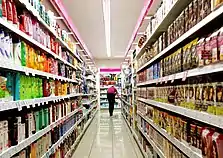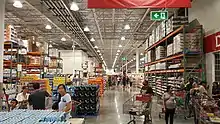


Fast-moving consumer goods (FMCG), also known as consumer packaged goods (CPG), are products that are sold quickly and at a relatively low cost. Examples include non-durable household goods such as packaged foods, beverages, toiletries, candies, cosmetics, over-the-counter drugs, dry goods, and other consumables.[1][2][3]
Fast-moving consumer goods have a high inventory turnover and are contrasted with specialty items which have lower sales and higher carrying charges. Many retailers carry only FMCGs; particularly hypermarkets, big box stores and warehouse club stores. Small convenience stores also stock fast-moving goods; the limited shelf space is filled with higher turnover items.
Characteristics
The following are the main characteristics of FMCGs:[1]
- From the consumer perspective
- Frequent purchases
- Low engagement (little or no effort to choose the item)
- Low prices
- Short shelf life
- Rapid consumption
- From the marketer perspective
- High volumes
- Low contribution margins
- Extensive distribution
- High inventory turnover
Consumer Packaged Goods Companies
The following are well-known Consumer Packaged Goods (CPG) manufacturing companies[4]
Rural consumers
Consumers in rural areas typically purchase goods from nearby towns and villages. Recently, there has been a shift in consumer purchase behavior toward purchasing locally that has prompted the need for better local promotional efforts to generate brand awareness in small towns. FMCGs play a large part in the economy, as they are inelastic products that touch every part of consumer life. Businesses that supply FMCGs to a rural community can help provide employment opportunities and drive down the cost of such products in those rural areas. For instance, FMCGs represent the fourth-largest sector in the Indian economy[5] and generate employment for more than three million people in downstream activities.[6]
ISIC definition
The retail market for FMCGs includes businesses in the following International Standard Industrial Classification (ISIC) (Revision 3) categories:[7]
- ISIC 5211 retail sales in non-specialized stores
- ISIC 5219 other retail sales in non-specialized stores
- ISIC 5220 retail sales of food, beverages and tobacco in specialized stores
- ISIC 5231 retail sales of pharmaceutical and medical goods, cosmetic and toilet articles
- ISIC 5251 retail sales via mail order houses
- ISIC 5252 retail sales via stalls and markets
- ISIC 5259 wholesale goods
- ISIC 5269 wholesale medical prescriptions
Supplier industries for FMCGs include:
- 1511 meat and meat products
- 1512 fish and fish products
- 1513 fruit and vegetables
- 1514 vegetable and animal oils and fats
- 1520 dairy products
- 1531 grain mill products
- 1532 starches and starch products
- 1533 animal feeds
- 1541 bakery products
- 1542 sugar
- 1543 cocoa, chocolate and sugar confectionery
- 1544 macaroni, noodles, couscous
- 1549 other food products
- 1551 spirits, ethyl alcohol
- 1552 wines
- 1553 malt liquors and malt
- 1554 soft drinks, mineral waters
- 1600 tobacco products
- 2101 pulp, paper and paperboard
- 2102 corrugated paper, containers
- 2109 other articles of paper and paperboard
- 2424 soap and detergents, cleaning preparations, perfumes
- 2430 men's and women's inner garments, shaving gels, deodorants, personal care, home care
See also
References
- 1 2 Ramanuj Majumdar (2004). Product Management in India. PHI Learning. pp. 26–27. ISBN 978-81-203-1252-4. Archived from the original on 2023-07-01. Retrieved 2010-06-19.
- ↑ Sean Brierley (2002). The Advertising Handbook (2nd, illustrated ed.). Routledge. p. 14. ISBN 978-0-415-24391-9.
- ↑ Nellist, George (2022-10-06). "By looking to nature, health products manufacturer Melaleuca is breaking barriers". Digital Journal. Archived from the original on 2022-10-09. Retrieved 2022-10-09.
- ↑ Jesse; Jesse (2020-04-30). "Top 10 Largest CPG Companies by Revenue in the World 2020 | CPG Industry Factsheet". Bizvibe Blog. Archived from the original on 2022-10-09. Retrieved 2022-10-09.
- ↑ "Indian FMCG Industry Analysis". www.ibef.org. Archived from the original on 2020-02-25. Retrieved 2020-02-25.
- ↑ Singaravelu, Dr. K. (October 2013). "Rural Consumer Behaviour on Fast Moving Consumer Goods" (PDF). Archived (PDF) from the original on 2018-10-08. Retrieved 2018-10-07.
- ↑ Aydın Çelen; Tarkan Erdoğan; Erol Taymaz (June 2005). "Fast Moving Consumer Goods Competitive Conditions and Policies" (PDF). Economic Research Center, Middle East Technical University. Archived from the original (PDF) on 2017-12-15. Retrieved 2007-07-09., p.2-4